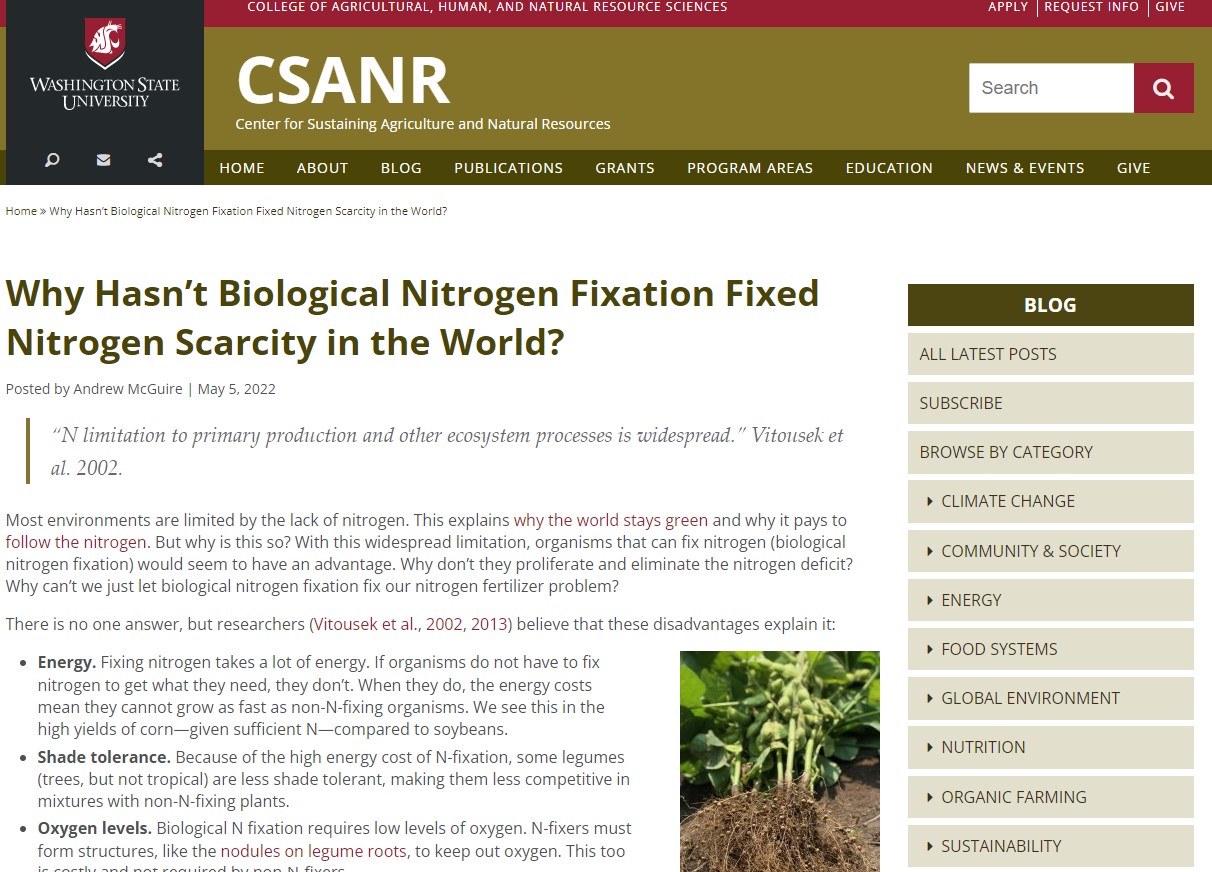Why Hasn’t Biological Nitrogen Fixation Fixed Nitrogen Scarcity in the World?
Really insightful piece from Andrew McGuire of Washington State University:

Most environments are limited by the lack of nitrogen. This explains why the world stays green and why it pays to follow the nitrogen. But why is this so? With this widespread limitation, organisms that can fix nitrogen (biological nitrogen fixation) would seem to have an advantage. Why don’t they proliferate and eliminate the nitrogen deficit? Why can’t we just let biological nitrogen fixation fix our nitrogen fertilizer problem?
There is no one answer, but researchers (Vitousek et al., 2002, 2013) believe that these disadvantages explain it:
- Energy. Fixing nitrogen takes a lot of energy. If organisms do not have to fix nitrogen to get what they need, they don’t. When they do, the energy costs mean they cannot grow as fast as non-N-fixing organisms. We see this in the high yields of corn—given sufficient N—compared to soybeans.
- Shade tolerance. Because of the high energy cost of N-fixation, some legumes (trees, but not tropical) are less shade tolerant, making them less competitive in mixtures with non-N-fixing plants.
- Oxygen levels. Biological N fixation requires low levels of oxygen. N-fixers must form structures, like the nodules on legume roots, to keep out oxygen. This too is costly and not required by non-N-fixers.
- Phosphorus and other nutrient levels. Nitrogen fixers require some nutrients in higher amounts than non-N-fixers. P, K, Fe, and molybdenum. Again, this limits N-fixation in environments with low levels of these nutrients. Alfalfa growers may not have to apply N fertilizer, but they will not make much hay without adequate soil-P levels. “Thus, N limitation to primary production on a whole-system level may be limitation by P (or another non-N nutrient) in disguise.” (Vitousek et al. 2013)
- Grazing. Because they need the high N content, herbivores (cattle, beetles, and such) often eat N-fixers over non-N-fixers, giving the latter an advantage. Graziers know this as the problem of keeping the legume-grass ratio constant over years.
There are no solutions. There are only trade-offs. — Thomas Sowell
So biological nitrogen fixation is not the free high-protein midday meal that we often think it is. Benefits? Yes, but don’t forget the costs; win-wins often mean you just haven’t looked closely enough.
REFERENCES
- Vitousek, P.M., K. Cassman, C. Cleveland, T. Crews, C.B. Field, et al. 2002. Towards an ecological understanding of biological nitrogen fixation. The Nitrogen Cycle at Regional to Global Scales. Springer, Dordrecht. p. 1–45.
- Vitousek, P.M., D.N.L. Menge, S.C. Reed, and C.C. Cleveland. 2013. Biological nitrogen fixation: rates, patterns and ecological controls in terrestrial ecosystems. Philosophical Transactions of the Royal Society B: Biological Sciences 368 (1621): 20130119. doi: 10.1098/rstb.2013.0119.
Discussion

I don’t see that Andrew's blog answers his question! Surely the lack of N accumulation in the ecosystem must be because the rate of loss of fixed N (whether biologically fixed or fixed via the Haber-Bosch process) exceeds the rate of fixation. The main N losses from farmed legumes are through their consumption by livestock (which he mentions) but then this is followed by haphazard excretion (which Andrew doesn’t mention) in concentrated patches / regions at rates which exceed plant or crop requirements and then gaseous or aqueous emissions of this N befo
